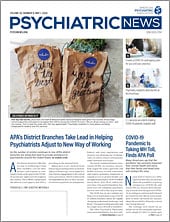For psychiatric inpatient facilities, the COVID-19 pandemic presents unique challenges related to space constraints, close contact between staff and patients, and structural barriers in care delivery, according to an article in press at Psychiatric Services.
“Beyond the direct challenges in physical space and exposure risks to staff and patients, there are additional indirect challenges that can impact services delivery in inpatient psychiatric settings during a pandemic,” wrote Luming Li, M.D., an assistant professor of psychiatry at Yale School of Medicine, medical director of clinical operations at Yale New Haven Medical Center, and associate medical director of quality improvement at Yale New Haven Psychiatric Hospital.
The situation for patients with psychiatric disorders may worsen, as public and clinical services close to limit social contact, potentially “exacerbating the duration that some individuals remain acutely ill,” Li wrote.
Li wrote the article after she and her colleagues developed their own contingency plan. “The administrative leadership team I’m part of has spent countless hours discussing various ways of addressing COVID-19 precautions. I thought that it would be helpful to have this information available as others work through challenges related to COVID-19,” she told Psychiatric News.
One of the most helpful aspects of her team’s approach, she said, was the previously established relationships between those in various leadership roles, including nursing and social work. “Those relationships have helped facilitate the work,” she said.
She emphasized the importance of communication and organized leadership. Without good communication, information is often passed between staff members in convoluted snippets, potentially resulting in unintentional staff or patient harm. In her hospital, she said, “if we need to communicate something, there is one single source of truth that is vetted with a group before getting communicated out.”
Li outlined five strategies for responding to COVID-19 in inpatient psychiatric facilities:
•
Manage COVID-19 precautions: Inpatient psychiatric facilities should consider screening patients for respiratory symptoms and fever prior to admission, as well as throughout the patient’s hospitalization. Staff should use personal protective equipment (PPE) when patients develop fever and respiratory symptoms. Surfaces should also be cleaned and disinfected often, especially those that are frequently used.
•
Restrict visitors and minimize nonessential contacts: An important decision point, Li explained, can be implementing visitor restrictions for family members, nonessential employees, and students to protect essential staff and patients from potential COVID-19 exposure. Preventing visitors, however, may impact patients’ treatment course, affect how patients reconnect with family members, and cause significant anxiety for family members.
•
Develop a contingency staff plan: Li noted that a national shortage of psychiatric providers will likely worsen during the COVID-19 pandemic, as psychiatrists are exposed and become ill. She said administrators and clinical leaders will need to identify strategies to address the provider shortage, such as creating a backup system of psychiatrists and other clinicians who can take over should those on the front lines become ill. Additionally, she recommended that facilities consider using telepsychiatry to deliver inpatient services while minimizing clinical staff exposure.
•
Plan for patients suspected of having COVID-19: Facilities may consider designated isolation rooms to group patients with COVID-19 symptoms. Patients who develop symptoms of the virus should immediately be given a mask and gown and isolated to minimize spread, Li advised. Due to the difficulty of isolating patients on psychiatric units, which often have open layouts, steps should be taken to transfer patients to inpatient medicine for COVID-19 testing. Patients who develop COVID-19 symptoms should be monitored closely for worsening of psychiatric symptoms and the emergence of new psychiatric symptoms. “If considered psychiatrically stable, the patient should be discharged to outpatient care and self-quarantine,” Li wrote.
•
Modify group therapy: Though group therapy can be an important aspect of treatment, facilities may need to change the way group meetings take place, including limiting the number of individuals who can participate at one time and enhancing social distancing. “However, limiting group treatment options and reducing group size may lead to more social isolation and loneliness, which may have, in part, contributed to hospitalization,” Li wrote.
Many of the decisions outlined in the article that hospital administrators are facing during the COVID-19 pandemic are very difficult to make, Li said. “Where we’ve been able to draw some courage and success is with distributed leadership,” she continued. Having local leaders, such as among the social work and nursing teams, has empowered the staff to make their own decisions within the guidance provided by top leadership.
“We have to be able to comfortably tell patients that they can no longer see visitors,” she said. “That’s really hard, on both the staff and patients.” But if staff develop their own, creative ways of fulfilling the guidance their leaders give them, “that is going to be much better than us as a leadership team telling individuals to do something in a particular way.” ■
This Open Forum article is in press at Psychiatric Services and can be cited as follows: Li L: Challenges and Priorities in Responding to COVID-19 in Inpatient Psychiatry. Psychiatric Services.

